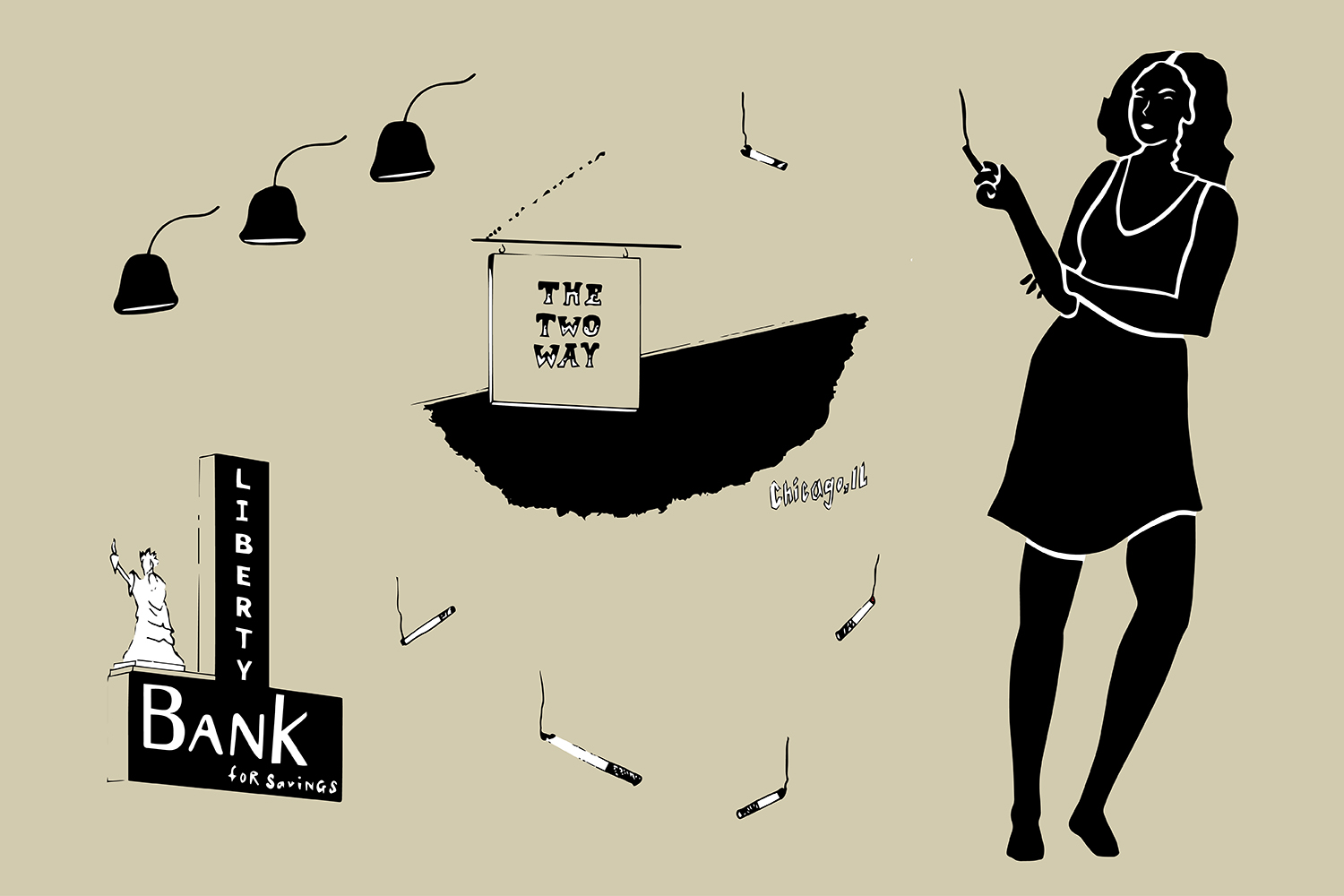There are certain bars—and they are rare, but there’s always one in every city—where you come to understand implicitly after hanging around long enough that the regulars turn into smoke or something when they’re not there. They have homes and jobs and other real but impossible-to-picture stuff, probably, but their life—like, the full bloom of it—happens inside of the same bar every night.
There were lots of other bars around Helen’s Two Way Lounge, but Two Way people went to the Two Way—it was that simple. You could go in through the Milwaukee Ave. door with the occasionally conscious bouncer, or the more dubious Fullerton Ave. door which deposited you straight into the vortex of Shakespearean tragicomedy and frequent violence that was the pool table. (Voila: Two ways.) I always secretly believed entering through the Fullerton door manifested on some cosmic level a spicier night.
It really didn’t matter which entrance you took, though: venturing inside the Two Way meant slipping into a Black Lodge where time went all Salvador Dali, jukebox wars descended regularly into bloodlust, bikers with visible recent stab wounds danced to reggaeton cheek-to-cheek with intoxicatedly glamorous Puerto Rican grandmothers, and everyone—and I truly mean everyone—drank $1 Old Style drafts that came spilling endlessly out of frosty mugs, so thoroughly saturating every surface of the place that the air constantly smelled like wet Saltines. I have yet to taste a more delicious beer in my entire life, and being occasionally threatened with death by a blacked-out, shirtless metalhead over putting Carly Rae Jepsen’s “Call Me Maybe” on the jukebox three or five times in a row was a completely reasonable price to pay.
There used to be a framed poster hanging over the toilet of the joyfully discreet single-stall women’s bathroom, and in that frame there was something I will call an “experimental map.” This map was foregrounded with a glorious Chicago skyline. Immediately behind that was “The Big Apple,” which faded into a thin strip of Atlantic Ocean, and then, just a skip and a jump later, “Europe.” I did not pretend to understand the map’s precise topographics, but it made sense there in that bathroom and nowhere else in the world, as was the case with most everything inside the Two Way. And we were there, too, in the only bar that gets it, whatever the fuck “it” was, as the entire rest of the world extended fuzzily outward toward some vague and unpersuasive future.
The best bars reject time and space by an unproven law of physics that nudges earth’s heliocentric orbit off its track until everything, instead, begins to revolve around the bar itself—a rogue black hole of sorts. That’s just science, and if Copernicus had ever been to the Two Way, he’d understand.
For a few years I found myself pulled into the Two Way’s strange gravitational field. In those days, I would sleep into mid-afternoon and draw like a woman possessed until dawn, but when I wasn’t doing that, I was at the Two Way, alone or with whomever else I knew needed to disappear for a few—or several—hours
Two Way afternoons meant $2 boilermakers and the kind of spontaneous, mind-fucking life stories that only come out in late spring after you start drinking at noon. They also meant you would probably find Maria, who I must’ve seen a hundred times at the Two Way but nowhere else in the neighborhood ever. Not at a grocery store, waiting for a bus, getting a coffee—nothing.
Maria was somewhere in her fifties with the soul of a deviant prom queen, with smudgy black eyeliner and peroxide-gold hair the exact color of 4pm sunlight filtered through black-tinted windows. It was obvious from the moment you met her that she was Queen of the Two Way, and she presided imperially over her domain, occasionally disappearing to the 7/11 across the way and returning with snacks for all. Usually she’d scan through the selfies in her phone to show me photos of her daughter in her Marines uniform, who she swore every time looked just like me.
I have never met anyone so fantastically boy-crazy as Maria. She’d cozy up to whichever twenty-something fixed-gear type or haggard former Latin King she deemed most eligible and, within a matter of minutes, would be lovingly tousling his hair, tossing her head back in peals of pure and divine girlish laughter. What made Maria happier than anything in the world was to dance, regardless of the song. She got the same thrill grinding to Daddy Yankee’s “Gasolina” as she did tangoing across the sticky linoleum-checkered floor to The Doors’ “People Are Strange.” I’d always kind of hated The Doors, but like everything else, they made sense at the Two Way, watching Maria spin with her eyes closed.
One night in August, when the air felt charged with the electric urgency of late summer Chicago and when, by sundown, all logic had evaporated into instinct, I saw Maria in her fullest glow. I remember it was August because it was Sharkula’s birthday—there was a cake and everything.
Sharkula, if you don’t know, is one of those characters as essential to Chicago folklore as Daley or Ditka or the guy outside the State Street Old Navy with the megaphone screaming about hell. A rambling man and true outsider artist, Sharkula was like Kool Keith, but weirder. Not much good usually follows the question, “Hey, you like hip-hop?” on the sidewalk, except in the case of Sharkula, who sold $5 mixtapes on burned CDs with titles like Martin Luther King Jr. Whopper with Cheese and Just For The Wizzard Haters. You always had to buy them, mostly because Sharkula needed beer, but also because they were amazing and when you get the chance to be a part of real-life mythology in the making, of course you take it.
So it was Sharkula’s birthday night, and the mood in Two Way was heaven. The jukebox was on the kind of unplannable hot streak where consecutive Dem Franchize Boyz and Alice Cooper songs felt like the collaborative braiding of a beautiful, freakish friendship bracelet instead of a call to arms. For once, no pool cues were brandished as weapons. The tamale guy weaved with his blue and red coolers, wafting little clouds of pork and corn, between tables of what felt like infinite, perspiring Old Style pitchers which had become implicitly communal after everyone had lost track of whose was whose. It was a perfect night. And in the center of it all was Maria, feeding cake with a fork to a young and sunburned Polish guido, whose tribal tattoos rippled on his biceps when they danced together. She looked like the patron saint of disappearing into your own life.
When you bought yourself a shot of Malort, you got one for Maria, too—an offering to the Queen of the Two Way. Old Style was the official nectar of the Two Way, but Malort was the elixir of ritual. A round of Malort shots forged a small but special bond. A night of Malort shots was more or less legally binding as far as lifelong friendship goes.
Malort, some would say, is not for everyone (a foreboding off-yellow liquid sporting the flavor of absinthe muddled with lawn clippings and a trace of not-quite-ripe grapefruit), which is exactly why it is, in fact, for everyone, if only to see their traumatized reactions. Originally home-brewed in the 1930s by mad genius Carl Jeppson, a Swedish immigrant to Chicago, Jeppson’s Malort is mostly only sold in the Chicago area, though it’s bottled exclusively in Florida, a fact that makes the same kind of sense as that restroom map. It is the kind of drink that makes you feel like a Viking or cowboy or something, the drink of a strange person fading into a strange night.
I spent three years wandering Brooklyn looking for anywhere that felt like the Two Way, though of course nowhere did. By the time I moved back to Chicago this January, the Two Way was gone. El Charro, the 24-hour Mexican restaurant next door whose burritos had saved my drunk, foolish life at least a dozen times, had been bought out months before to be transformed into a ramen shop that smelled like gentrification. Everyone could see what was going to happen next, and sure enough, not long after, the Two Way had been officially sold to the owners of the ramen spot, drastically renovated, and reborn under a seriously uncharismatic new name I cannot bring myself to type.
I haven’t been, and I never will go, but I’ve seen pictures, “urban-rustic” or whatever, with sad faux-vintage chandeliers and antlers on the wallpaper. The cocktail menu’s options include something called a “brojito” and a “millennial mudslide.” Sometimes I convince myself it’s for the best that the Two Way’s gone, because you can’t just keep on slipping into that weird black hole forever, with all the others that bloom only at night. And then I think about Maria, and wonder where she’s disappearing now.












